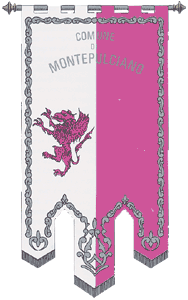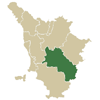|  Inhabitants in 1991: 13.856 Inhabitants in 1991: 13.856
 IThe
municipal territory of Montepulciano extends for 165,58 square kilometres
on the plain and in the hills which separate the Val di Chiana from the
Val d’Orca. Free municipality then Podesta office, it became
Seat of Captaincy, with successive modifications and territorial
contrasts, above all with the nearby community of Chainciano. IThe
municipal territory of Montepulciano extends for 165,58 square kilometres
on the plain and in the hills which separate the Val di Chiana from the
Val d’Orca. Free municipality then Podesta office, it became
Seat of Captaincy, with successive modifications and territorial
contrasts, above all with the nearby community of Chainciano.
Probably inhabited in the Etruscan and Roman eras, the castle of Montepulciano
is recorded for the first time as a fortified centre in a document
of 715. With the dissipation of the Carolingian order the dominion
of the family of Scialenghi and that of the Manenti da Sarteano
was affirmed, but already during the XII century the free municipality
was developing with their own political and administrative structures,
at first allied with Siena. At the beginning of the XIII century
however the inhabitants, wanting to contrast the expansionism of Siena
and themselves desirous of constructing their own territorial dominion,
allied themselves with the Fiorentini. This was the start of the
long contest between the two major cities for the possession of Montepulciano,
which for three centuries with alternating events, constituted one of
the fundamental objectives of the struggle. Defeated the first time in
1208, Siena in 1229 allying itself with the ancient feudal Lords
expulsed from Montepulciano, attempted the conquest; with the initial
victory over the Fiorentini, and in 1232 razed the wall and towers
of the castle. But the fate of conflict soon turned against them and
they were forced to pay the necessary amount for the rebuilding of Montepulciano.
Re-entered in the Siena orbit with the defeat of the Fiorentini at
Montaperti (1260) the castle, after the battle of Benevento, went
again under the protection of Firenze and only with the coming to power
by the Guelfe in Siena (1287) and the period of relative peace between
the two city did Montepulciano start a long period of dependence to
Siena, extending until almost the middle of the XIV century. In this
year Montepulciano re-enforced the municipal institutions but were also
divided internally by the struggles between the districts and power groups:
the family Del Pecora assumed particular importance during this period.
In 1390 Montepulciano passed under the sovereignty of Firenze who
took care of the restoration of the walls and the construction of a new
fortress. At the end of the XV century the inhabitants, pushed above all
economic reasons, again attempted to get close to Siena; but after a period
of encounters and diplomatic treaties the Fiorentini in 1511 reconquered
it definitively. In 1561 Montepulciano was raised to Episcopal Seat,
then obtained the dignity of City, and in that year also drew up a
new municipal statute; from 1609 to 1637 it became, with all its territory
feudal to Cristina di Lorena widow of Ferdinando I, it returned under
the direct jurisdiction of the Grand Duchy. Montepulciano rich in Medieval
monuments and imposing late Renaissance churches which document the importance
of the city in that time, is the birth place of famous people like
the humanist Agnolo Ambrogini, called the Poliziano (1454-1494),
Cardinal Roberto Bellarmino and Pope Marcello II (Marcello
Cervini, 1501-1555).
Places to visit:
Piazza Grande, from early times
the civil and religious nucleus of the town, it was transformed in
its present day form in the 1500s. It is surrounded by Medieval palaces,
among which the Palazzo Comunale, with a 1300s beautiful courtyard
it was remodelled in 1400: its imposing façade was almost certainly
designed by Michelozzo. Palazzo Nobili-Tarugi, 1500s construction
said to have been designed by Antonio da Sangallo il Vecchio, and
beautified by a Loggia Palazzo del Monte Cantucci, begun in
1519 by Antonio da Sangallo il Vecchio for the Cardinal del Monte,
it was successively remodelled and enlarged.
Palazzo Avignonesi, erected in 1500 on a pre-existing family
house, it is an imposing construction in Travertino stone with the
main door framed in Bugnato and flanked by lion’s heads.
Civic Museum and Crociani Picture Gallery, housed in the Palazzo
Neri-Orselli, it is composed of precious paintings from the Siena
and Firenze school and with works by Andrea della Robbia.
Cathedral, dominating Piazza Grande and built on the place
of the extremely ancient parish church of Santa Maria demolished at
the end of the 1500s. The incomplete façade raises from a flight
of steps and is dominated by the 1400s bell tower. The three nave
Latin cross interior preserves diverse works of art among which the
XIV century Baptismal font and the 1400s triptych by Taddeo di Bartolo.
S. Francesco, 1200s Francescana church restored in the 1800s
preserves a fresco from the 1300 Siena school.
S. Biagio, Renaissance monumental construction outside the
town, in an isolated and suggestive position, it is the masterpiece
of Antonio da Sangallo il Vecchio. Constructed from 1518 to 1545 in
Travertino Stone has Greek cross interior with central dome where
precious works of art are conserved. |
Historical info reproduced upon authorization of
Regione Toscana - Dipartimento della Presidenza E Affari Legislativi e
Giuridici
Translated by Ann Mountford
Picture by Sandro Santioli |